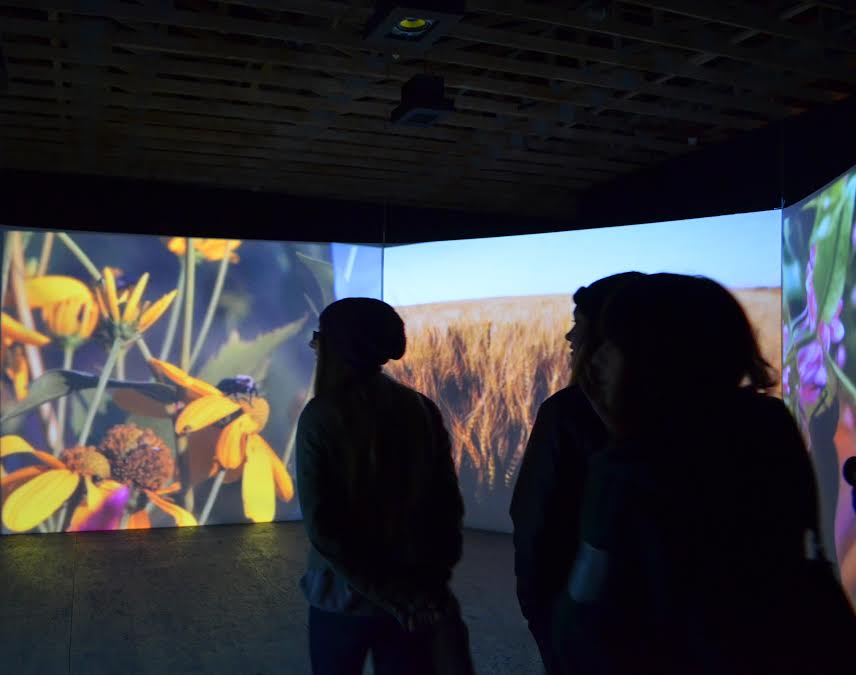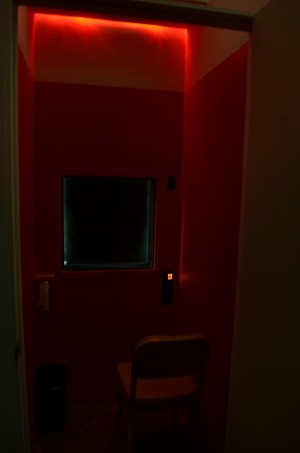
Postcommodity's four-channel video and sound installation, Promoting a More Just, Verdant and Harmonious Resolution, as installed at SMoCa. Photo: Julie Ganas. Courtesy of SMoCa
SouthwestNET: Postcommodity Brings Disruptive Metaphor, Purposefully, to SMoCa
The four members of Postcommodity collective are Raven Chacon, Cristóbal Martínez, Kade L. Twist and Nathan Young. Raven Chacon lives in Albuquerque, Kade Twist in Santa Fe. Cristóbal Martínez, who was raised in northern New Mexico, is finishing his PhD at Arizona State University. He will be defending his dissertation in the art galleries at Scottsdale Museum of Contemporary Art, near the collective’s exhibition titled southwestNET: Postcommodity, sometime during the month of March (at press time). Nathan Young resides in Oklahoma.
The collective creates large scale, non-objective installation work. They describe the motivations of their 2006 founding in terms both pragmatic and aspirational. The economy of scale to be a collective of four indigenous artists working to build metaphor-rich projects has been significant, they say. They also rely on a process of vigorous internal research and debate as they work to devise installations that forge new metaphors that challenge destabilizing global economics. Cultural hegemonies and alternatives mark another metaphoric ground on which their art communicates.
Postcommodity has exhibited in Canada, Belgium, Australia, the Czech Republic as well as many venues in the southwestern United States and California. In 2015 they begin preparations to stage a land installation near Douglas, AZ that will take place in October.
I interviewed Chacon, Martínez and Twist by telephone as they were installing southwestNET at Scottsdale Museum of Contemporary Art. The show went on view at on January 31st, with a public opening occurring on Friday, February 6th.
Where and when did Postcommodity form?
Kade Twist: Postcommodity formed in Phoenix in 2006. We started doing work in 2007 in Czech Republic at Centre for the Future, a sister organization to Telluride Institute.
We formed the collective to utilize the best indigenous artists that could actually collaborate together, dudes that got along . . . to make the best work possible, to make large-scale work. We didn’t form Postcommodity to make small-scale sculptural objects.
Why did Postcommodity form?
Kade Twist: We wanted to make work (collectively) that would be very expensive for our individual practices. We do work collectively from research to testing to implementation. We are able (as a collective) to leverage our research, our time, our skill sets. We can accomplish a 4:1 savings scale over what an individual artist could accomplish with a $10,000 budget.
That was it on the pragmatic side. The other side was (to amplify) indigenous discourse. We really were discourse-driven from the beginning. We wanted to push and stretch and pull.
Since 2007 you’ve had six solo exhibits of which southwestNET is one. You’ve been in multiple group exhibitions including at the 18th Sydney Biennale. As you go forward with non-object based work or social practice art or both, talk about how you see the situation for the kind of art that you make around the globe?
Cristóbal Martínez: First I would say that our work is like convolution media. It represents the trans-disciplinary nature of our collective, four guys who come with distinct indigenous cultural backgrounds and disciplinary backgrounds. When we get together we’re bringing all this expertise together and bringing them into forms of cohesion that are designed to generate dialogue and discourse within the context of global market systems and within the context of various indigenous social, political and cultural issues.
I see us as a group whose practice is about creating a lot of noise and a lot of confusion to try to disrupt the oversimplified cultural models that are produced by mass media.
KT: There’s one thing I would add. A lot of what we try to do is creation metaphor that can serve as a benchmark for rationalizing contemporary experience and trying to position (the work’s) metaphors in ways that enhance our discourse and our dialogue and advance the potential of the piece. We have long, long discussions about these metaphors that we work with and push and pull around and stretch. Stretch meaning, stretch expectations and embrace complexity rather than the binary.
CM: We’re also driven to proliferate. This goes back to your question about the state of our work within the context of the art world. We’re working to proliferate the art world with indigenous epistemological world views. We’re trying to break that art discourse so hopefully it becomes more inclusive over time.
What shifts when you move your work into institutions?
Kade Twist: It’s bringing a visual metaphor into the visual context or the sonic context or the experiential context within any given space or environment. It doesn’t matter where we work. One environment isn’t necessarily at a disadvantage or an advantage. It’s creating containers for metaphor to be realized and to be readable and be engage-able. Readability is something we’re very concerned with, the balance between avoiding didacticism and making sure your flexibility is processed.
You’ve said in the past that your work critiques issues from the quote unquote industry of sustainability to the proliferating cultures of violence. Is there a specific issue that the SMoCa show will take on?
Cristóbal Martínez: One of the major topics our show is going to be taking on is this idea of violence capitalism and looking at the ways by which multinational oligarchy is forming. We’re critiquing the ways by which speculative capitalism that is supporting the formation of that oligarchy is destabilizing nations and communities around the world. We’re critiquing that process and highlighting the idea that our market system is actually straining our diplomatic ties around the world.
Kade Twist: Culture is used as a positioning lubricant. A way of disciplining consumers and the supply chain. Culture plays a very important role for legitimacy and for orienting products within a particular community or a global region. Culture is a very important negotiation tool. It’s a way of negotiating and rationalizing.
What do you mean by culture?
Kade Twist: Culture represents political and economic interests of America. Not to be all Noam Chomsky or anything but for sure American cultural byproducts and TV, music, films are positioned to be the most acceptable, most ideal, legitimate forms of art. The English language is positioned to be most legitimate form of language used. English is the lingua francua of rock ‘n’ roll music. It’s that type of thing. Taking culture out of its intended context and using it as a commodity.
Cristóbal Martínez: It’s also the idea of weaponizing that culture, not only the rock music but the female nude. Weaponizing the sexual representations of women and taking that discourse a step further as a way to then exploit women like in maquiladoras. There’s a relationship between the Sports Illustrated swimsuit model and the factory worker working south of the border.
You have two installations in the SMoCa show. Will be able to see visual and sonic representations of these ideas?
Raven Chacon: There is a sound shrapnel piece (Promoting a More Just, Verdant and Harmonious Resolution). The other piece is called Pollination, an installation in the form of a peep show.
Kade Twist: What you find in a piece like Promoting is you find fragments of idealic (idyllic) American popular culture. The explosions that are created are actually created out of hundreds and hundreds of samples of pop cultures. We’re creating cultural shards as a way of looking at what the real bombs are. The real bombs are activities or actions of cultural propagation, cultural manipulation.
Cristóbal Martínez: To be more specific about “the bombs,” we worked with military bomb experts and were able to procure data of explosions of fertilizer bombs used in Iraq and Afghanistan. We’ve mapped that data to samples of popular music so when people are in the space they’re experiencing the idyllic commercial nature of the puritanical Judeo-Christian world view of nature. If you happen to step on a sensor under the floor, an IED, you set off a blast of American or European popular music. The amplitude of the blast is in the shape of the bomb data.
Everything goes bright. All the videos go bright. Flash and noise–it’s where corporate propaganda gets massively disrupted by the blasts. Generating confusion because you have a blast that’s disrupting the blasts.
Will people have to sign waivers at the door?
Kade Twist: We don’t foresee that people will have to sign anything. Regarding Scottsdale, it’s a very sophisticated art community. SMoCa though young has mounted quite a number of amazing shows. It’s broadly in place. It’s part of the bedrock of the contemporary art community for the larger Phoenix area.
Cristóbal Martínez: I hope that our work is broadly disruptive. I hope people of all political persuasions show up.

